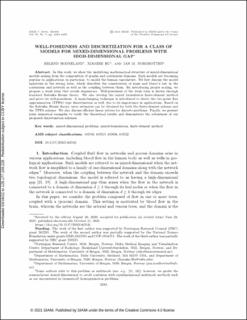| dc.contributor.author | Hodneland, Erlend | |
| dc.contributor.author | Hu, Xiaozhe | |
| dc.contributor.author | Nordbotten, Jan Martin | |
| dc.date.accessioned | 2022-03-16T13:47:54Z | |
| dc.date.available | 2022-03-16T13:47:54Z | |
| dc.date.created | 2021-11-04T18:24:32Z | |
| dc.date.issued | 2021 | |
| dc.identifier.issn | 0036-1399 | |
| dc.identifier.uri | https://hdl.handle.net/11250/2985610 | |
| dc.description.abstract | In this work, we show the underlying mathematical structure of mixed-dimensional models arising from the composition of graphs and continuous domains. Such models are becoming popular in applications, in particular, to model the human vasculature. We first discuss the model equations in the strong form, which describes the conservation of mass and Darcy's law in the continuum and network as well as the coupling between them. By introducing proper scaling, we propose a weak form that avoids degeneracy. Well-posedness of the weak form is shown through standard Babu\v ska--Brezzi theory. We also develop the mixed formulation finite-element method and prove its well-posedness. A mass-lumping technique is introduced to derive the two-point flux approximation (TPFA) type discretization as well, due to its importance in applications. Based on the Babu\v ska--Brezzi theory, error estimates can be obtained for both the finite-element scheme and the TPFA scheme. We also discuss efficient linear solvers for discrete problems. Finally, we present some numerical examples to verify the theoretical results and demonstrate the robustness of our proposed discretization schemes. | en_US |
| dc.language.iso | eng | en_US |
| dc.publisher | SIAM | en_US |
| dc.rights | Navngivelse 4.0 Internasjonal | * |
| dc.rights.uri | http://creativecommons.org/licenses/by/4.0/deed.no | * |
| dc.title | Well-posedness and discretization for a class of models for mixed-dimensional problems with high-dimensional gap | en_US |
| dc.type | Journal article | en_US |
| dc.type | Peer reviewed | en_US |
| dc.description.version | publishedVersion | en_US |
| dc.rights.holder | Copyright 2021 SIAM | en_US |
| cristin.ispublished | true | |
| cristin.fulltext | postprint | |
| cristin.qualitycode | 2 | |
| dc.identifier.doi | 10.1137/20M1362541 | |
| dc.identifier.cristin | 1951553 | |
| dc.source.journal | SIAM Journal on Applied Mathematics | en_US |
| dc.source.pagenumber | 2218-2245 | en_US |
| dc.relation.project | Norges forskningsråd: 250223 | en_US |
| dc.identifier.citation | SIAM Journal on Applied Mathematics. 2021, 81 (5), 2218-2245. | en_US |
| dc.source.volume | 81 | en_US |
| dc.source.issue | 5 | en_US |

